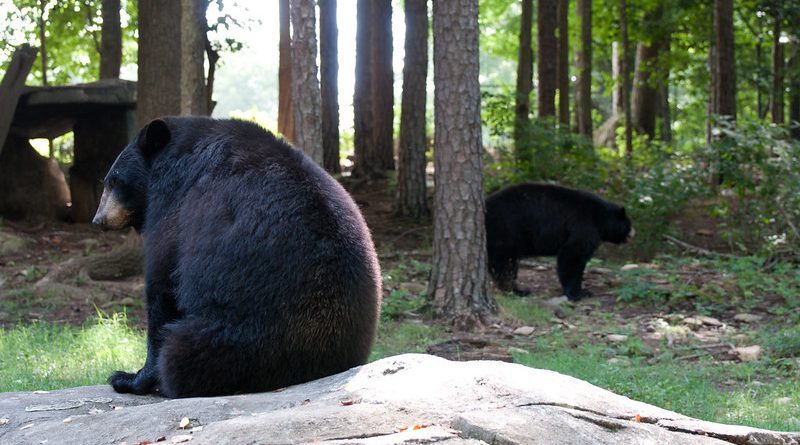Quebec For Wildlife Enthusiasts: Discover The ‘Big Five’
Québec’s unspoilt landscapes, lush forests, over a million lakes and pristine waterways including the mighty Saint Lawrence River make the province a haven for over 650 species of fauna, including 90 mammals and 300 birds. Each year nature lovers travel from across the globe to see Québec’s spectacular wildlife in its natural habitat. With three main climates and four distinct seasons, it’s no surprise that wildlife flourishes in Québec’s natural environment and there are a wide range of wildlife watching opportunities for visitors throughout the year.
So which species make up Québec’s ‘Big Five’? Here is a list of just five of the incredible species visitors can observe in Québec and the best time and place to see them.
Black Bear
Of the approximately 800,000 black bears that inhabit North America’s forests, 60,000 can be found in Québec. Guests can view these timid and iconic creatures across many regions, including Mauricie and the Québec Maritime region. At the log inn, located in Aux Berges du St-Maurice guests can bear watch at sunset accompanied by a qualified guide into the ‘bear’s valley’ and seek refuge in the camp as a post to spot the infamous black bear. Additionally, at Bioparc de la Gaspésie in the Québec Maritime region, a boardwalk has been built to provide visitors with a unique viewpoint from which to observe the bears. Black bears hibernate during the winter months and so summer is the best time of year to spot them.
Grey Wolf
Québec is home to the fourth largest wolf population in Canada. Over 7,000 wolves predominantly inhabit areas north of the Saint Lawrence River and the species generally avoids areas with dense human populations. The Grey Wolf can be observed year-round and the best places to spot this endangered species can be within protected reserves such as the Papineau-Labelle Wildlife Reserve and Laurentides Wildlife Reserve but there are also several other ways to observe the elusive grey wolf. These range from wolf calling activities to up close and personal encounters with a 30-strong pack of wolves at Parc Mahikan, located in Girardville north of Lac-Saint-Jean. The park of Mahikan, which means ‘wolf’ in Innu language, is one of the leading observation centres exclusively dedicated to wolves in Canada. New for 2019 guests can experience a night in the wolf cabin in Park Omega, a site with self-drive safaris and walking trails in Outaouais. The luxurious cabin’s panoramic windows offer unrestricted views of these incredible canines, as visitors experience face to face interactions unlike anywhere else.
Blue Whale
Between May and October, Québec’s Saint Lawrence River comes alive during the migration of 13 species of whale, including the majestic blue whale. The Saint Lawrence River is one of the longest rivers in North America and the outflow for the entire Great Lakes system. Each year the river becomes the seasonal residence of the largest group of blue whales in the Northern Hemisphere, as the whales migrate here to feed on krill. It is at the point where the salt waters of the Atlantic meet the freshwater carried from Lake Ontario that attracts the krill, making the Saint Lawrence estuary an important feeding-ground for marine mammals. The best place to spot the whales is at the mouth of the Saguenay Fjord. A number of whale watching experiences depart from Tadoussac on the north shore and Baie-Sainte-Catherine on the south. Whether aboard a sightseeing boat, zodiac or sea kayak, the tours offer the perfect opportunity to see these gentle giants up close, including blue whales and humpbacks! Guests can also learn more from specialists at the Marine Mammal Interpretation Centre in Tadoussac.
Moose
The moose population of Québec has doubled since the 90s to around 120,000. This North American giant – the biggest antlered animal on the planet – can weigh up to 600kg. Antlers start to appear on the males in the middle of summer and reach full size by early September, just in time for mating season. Even with their fall antlers, moose can move through the forest without making a sound. Moose can be found in nature reserves across Québec, such as the Gaspesie National Park, with guided hikes and photo safaris offering the best way to see these iconic creatures. The Montmorecy Forest is the largest teaching forest in the world and is located just outside of Québec City. Observation moose safaris run in September and October with guests learning how to track moose, study the creatures in their rutting season and observe their behaviour in the company of an experienced naturalist guide.
Snowy Owl
Shy and nomadic, the stately Snowy Owl is the official bird of Québec easily identified as a large, white owl with no ear tufts. Females and young males are flecked black or brown while the male’s plumage becomes immaculate white as it grows older. Unlike most owls, the Snowy owl is diurnal which means that it is active during the day. This adaptation is not surprising considering daylight is continuous within the Arctic Circle where they birds can be found during much of the summer nesting season. The owl’s stunning white plumage allows it to stay camouflaged in the arctic tundra of far Northern Québec, where the birds can be sighted in the summer, however snowy owls often visit southern Québec during the winter months. In recent years, an abundance of food in nesting areas has resulted in a spike in sightings of these impressive owls further south. Refuge Pageau in western Québec, which offers shelter to wild animals in need of rehabilitation, also houses a number of snowy owls for visitors to observe.
More Information
QuébecOriginal
QuébecOriginal are the official representatives of QuébecOriginal in Europe.




